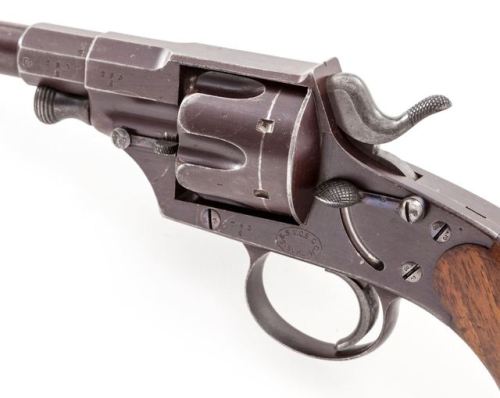The German Reichsrevolver,After the unification of Germany in 1871 the newly formed German Army soug
The German Reichsrevolver,After the unification of Germany in 1871 the newly formed German Army sought to standardize all weapons and equipment. Before unification Germany consisted of a collection of independent states and kingdoms, each with their own small arms, artillery, and close quarter weapons. The German Army began by standardizing their rifles, then their artillery, then their cavalry equipment. At the bottom of their list, and certainly their lowest priority was the creation of a standard side arm.The Model 1879 Reichsrevolver is not a complex revolver, a surprise considering that Germany has always had a reputation for producing revolutionary weapons designs. It was a simple and robust revolver, but unfortunately the M1879 was far outdated before it even hit the drawing board. It was a six shot single action revolver, meaning that the hammer had to be cocked before each shot. Loading was done through a loading gate on the right hand side of the pistol, basically the user would half cock the hammer, which would allow the cylinder to spin freely. The user would hand rotate the cylinder and insert cartridges one at a time. Incredibly, the M1879 lacked an ejector rod, typically a spring loaded rod that was integrated with the pistol which was used to eject empty cartridge casings from the chambers. Instead the user carried a separate rod in an ammunition belt and used it to punch out empty casings by hand. Another interesting feature of the Reichsrevolver was a safety, located on the left hand side of the pistol. When activated the hammer could not be cocked. Such a feature is rare on single action revolvers because it is very difficult to accident cock such a pistol. The Reichsrevolver’s safety mechanism makes it an oddity among other single action revolvers. Another problem with the M1879 was that it’s ergonomics were terrible. It’s a big honkin’ pistol that really wasn’t designed to fit the hand very well. Even a German with larger than average hands may have a hard time aiming, cocking, and firing the revolver comfortably. The Model 1879 Reichsrevolver was a very quaint and dated design for it’s time. By the late 1870′s Belgian, French, English, Austrian, and American gun designers were making revolvers, both single action and double action, that were far better than the M1879 and had many unique and revolutionary design elements.. A good example was the Colt M1873 Single Action Army, the classic cowboy gun which shares the same features of the Reichsrevolver. Despite being introduced years earlier, it was a far better pistol with better ergonomics, better weight and balance, and of course it had an ejector rod. The Colt 1873 is the simplest example, by the late 1870′s European pistol designers had created double action models, swing out cylinder models, top break systems, and even auto ejectors. While the Reichsrevolver was lacking in most areas, there are some advantageous features. First and foremost the Reichsrevolver was a simple and robust pistol. When you cocked the hammer and pulled the trigger it went bang, and it could take a beating and still keep going bang. It was also very easy to mass produce. Finally it was chambered for a 10x25mmR cartridge which was essentially a clone of the Smith & Wesson Russian,which was a very hard hitting cartridge.Despite these advantages the Reichsrevolver is kind of disappointing because Germany could have done better, but pretty much made an active decision not to. Germany had a long history of firearms design before then, going back to early wheel-lock rifles, to flintlock jaeger rifles, the revolutionary Dreyse Needle rifle and Krupp artillery. Germany certainly had the know-how, technical ability, industry,and resources to create something much better, but they didn’t. The German Army got what it wanted, a simple, functional, and rugged revolver that was cheap and easy to produce with no frills, bells, and whistles. It’s interesting to note that a generation later, Germany would suddenly spead ahead at warp speed with semi automatic designs such as the Borchardt, Luger pistol and Mauser Broomhandle In 1883 Germany would introduce a new model of the Reichsrevolver called the Model 1883, which featured a smaller barrel, smaller frame and a smaller better shaped grip to fit the hand. Collectors typically refer to the M1879 as the “Cavalry Model” and the M1883 the “Officers Model”. However those are just collectors designations and neither was exclusively issued to cavalry or officers. Interestingly, a number of smaller firms would take up the design and produce their own versions for the commercial market. These designs upgraded the Reichsrevolver with double action variants, pocket revolvers, and of course the addition of a proper ejector rod. One of the most interesting designs was a pocket revolver called the “Baby Reichsrevolver” which featured two triggers, the first which rotated the cylinder, the second which fired the revolver. It also featured a proper ejector rod.The Reichsrevolver would serve the German Army throughout the 1880′s and 1890′s, being officially retired in 1908 with the adoption of the Luger semi automatic pistol. However, the outbreak of World War I brought the Reichsrevolver back into regular use as the war created a shortage of pistols. They were quickly taken out of storage, dusted off, and typically issued to secondary troops such as supply, artillery, and reserve units. Supposedly they were even issued to Volkssturm units during World War II, although I’ve never found any hard evidence supporting this. -- source link
Tumblr Blog : peashooter85.tumblr.com
#guns#firearms#pistols#revolvers#antiques#history#gunblr


